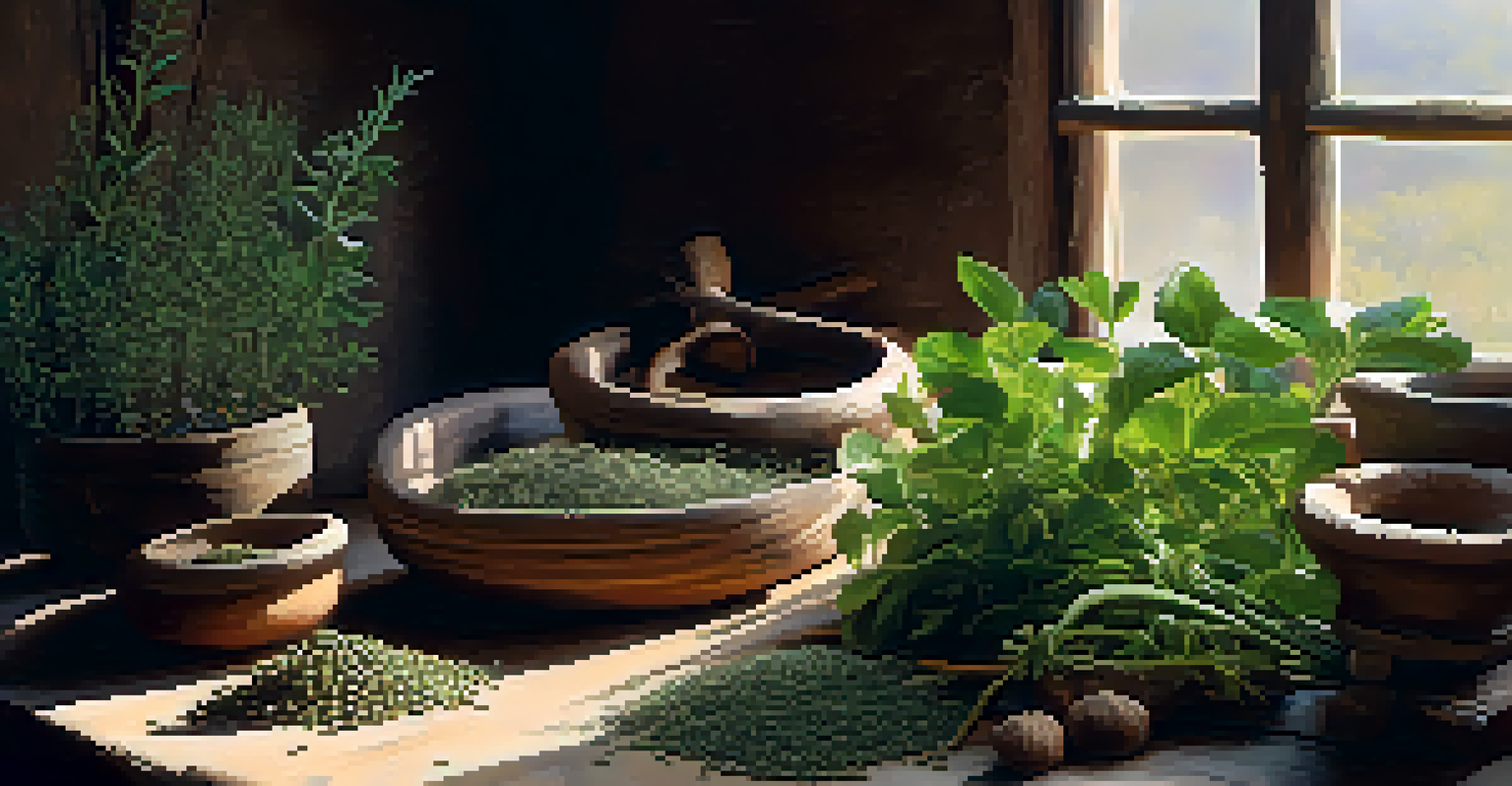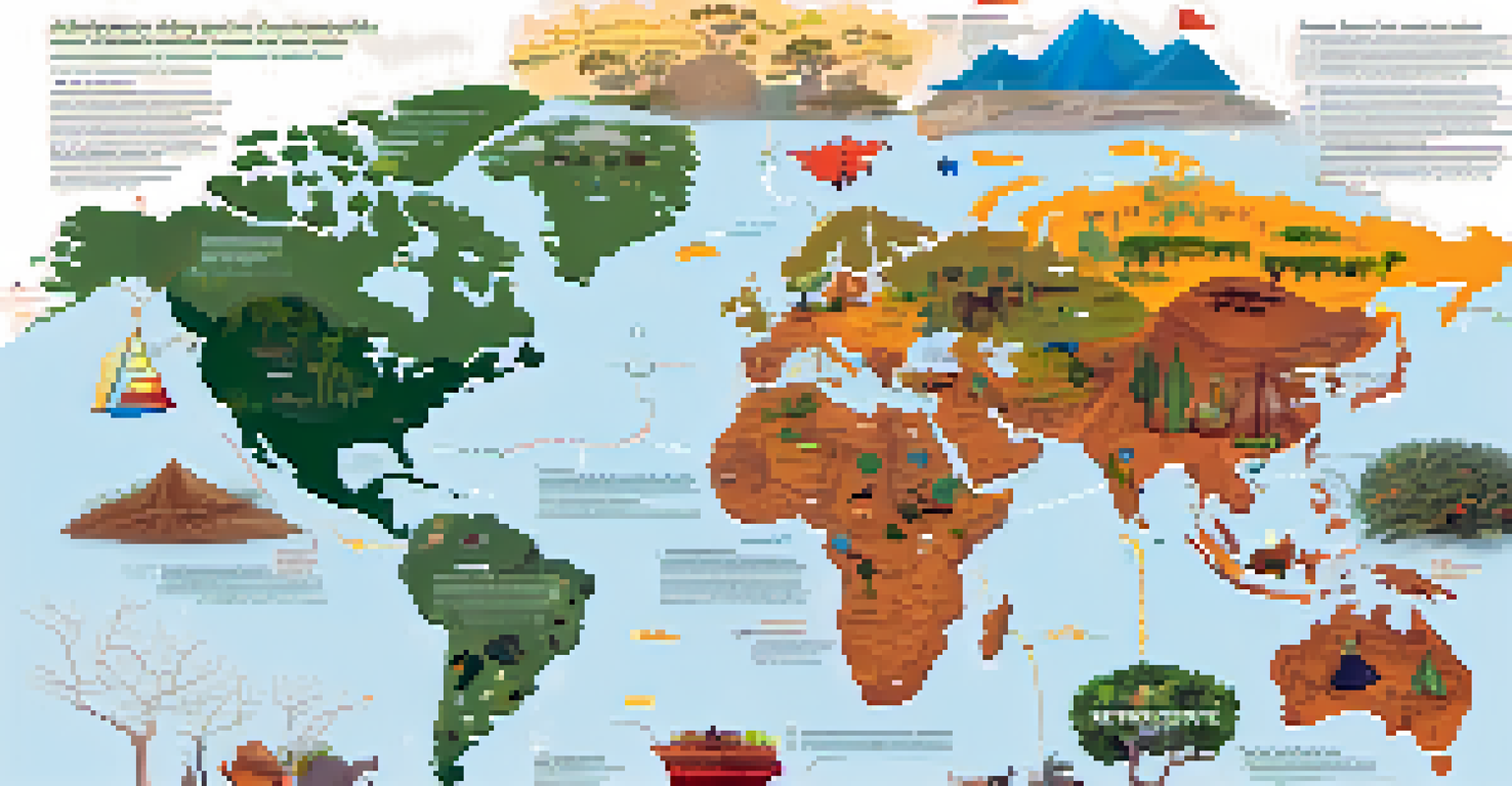Ethnobotanical Studies: Documenting Plant Use Across Cultures

Understanding Ethnobotany and Its Importance
Ethnobotany is the study of how different cultures use plants for various purposes, including food, medicine, and rituals. It connects the fields of botany and anthropology, emphasizing the relationship between people and their environment. By documenting these uses, ethnobotanists can preserve traditional knowledge that is often at risk of being lost.
Plants are the foundation of all life on earth, and understanding how different cultures interact with them is key to preserving biodiversity and cultural heritage.
One fascinating aspect of ethnobotany is its role in biodiversity conservation. As we learn about the ways cultures interact with plants, we can better understand the importance of preserving these species and their habitats. For instance, indigenous communities often maintain sustainable practices that contribute to the health of ecosystems.
Moreover, ethnobotanical studies can lead to new discoveries in medicine and agriculture. The knowledge of traditional plant uses can inspire modern scientific research, potentially leading to the development of new drugs or sustainable farming techniques. This intersection of old and new highlights the value of preserving cultural practices.
Historical Context of Ethnobotanical Research
The roots of ethnobotanical research can be traced back to the early 20th century when scientists began to systematically document the plant uses of indigenous populations. This period marked a growing interest in how traditional knowledge could contribute to scientific understanding. Researchers like Richard Evans Schultes paved the way, exploring the Amazon rainforest and documenting the diverse plant use of local tribes.

As the field evolved, it began to embrace a more holistic perspective, recognizing that cultural practices and beliefs shape plant use. This shift encouraged collaboration between scientists and indigenous communities, leading to more respectful and ethical research practices. Today, ethnobotany is not just about collecting data; it's about building relationships and fostering mutual respect.
Ethnobotany Preserves Cultural Knowledge
Studying how cultures utilize plants helps document and protect traditional practices at risk of disappearing.
Ethnobotanical research has also faced challenges over the years, including issues of intellectual property rights and cultural appropriation. As awareness of these issues grows, researchers are increasingly focused on ethical practices that honor the knowledge of indigenous peoples while promoting fair collaboration.
Methodologies in Ethnobotanical Studies
Ethnobotanical studies employ various methodologies to gather information about plant use. Common approaches include interviews, participant observation, and surveys, all aimed at understanding how communities interact with their botanical environment. For instance, researchers may conduct interviews with local healers to document traditional medicinal practices.
Ethnobotany is a bridge between science and culture, revealing how traditional knowledge can inform modern practices and innovations.
Fieldwork is a crucial component of ethnobotanical research, allowing scientists to observe plant use in its natural context. This hands-on approach helps researchers gain a deeper understanding of the cultural significance of certain plants. By being present in the community, they can also witness the rituals and practices that surround plant use.
Additionally, researchers often combine qualitative and quantitative methods to provide a comprehensive picture of plant use. This means not only documenting what plants are used but also analyzing how frequently they are utilized and their significance in the community. Such thorough investigations lead to richer insights into the cultural landscape of plant use.
Case Studies: Ethnobotany in Action
One notable case study is the use of the ayahuasca plant among Amazonian tribes. This psychoactive brew is more than just a hallucinogen; it's integral to spiritual practices and healing rituals. Ethnobotanical research has helped to document the traditional methods of preparation and the cultural significance of ayahuasca, shedding light on its role in indigenous identity.
Another example can be found in the use of medicinal plants by African communities. Many tribes rely on local flora to treat ailments, with extensive knowledge passed down through generations. Ethnobotanists have worked with these communities to catalog their medicinal practices, contributing to both cultural preservation and potential pharmaceutical innovations.
Ethical Challenges in Research
Modern ethnobotanists must navigate issues of trust and intellectual property rights to ethically engage with indigenous communities.
These case studies illustrate the diverse applications of ethnobotanical research, highlighting how traditional knowledge can inform modern science. They also emphasize the importance of community involvement in research, ensuring that indigenous voices are heard and respected.
The Role of Technology in Ethnobotanical Studies
With advancements in technology, ethnobotanical studies are becoming more efficient and comprehensive. Tools like Geographic Information Systems (GIS) allow researchers to map plant distribution and usage across different cultures. This spatial analysis helps to visualize the relationships between people and plants, revealing patterns that may not be immediately apparent.
Digital platforms are also enhancing the documentation process. Ethnobotanists can now use apps and online databases to record plant uses and share their findings with a global audience. This democratization of knowledge fosters collaboration among researchers and indigenous communities, promoting greater awareness of ethnobotanical resources.
Moreover, technology can assist in the conservation of traditional knowledge. By creating digital archives, researchers can preserve the stories and practices associated with plant use, ensuring they remain accessible for future generations. This integration of technology into ethnobotany underscores the importance of innovation in preserving cultural heritage.
Challenges in Ethnobotanical Research
Despite its potential, ethnobotanical research faces several challenges that can hinder its effectiveness. One major issue is the risk of losing traditional knowledge as younger generations move away from rural areas. As modernization continues, there is a growing gap between traditional practices and contemporary lifestyles, putting this valuable information at risk.
Additionally, researchers often encounter difficulties in establishing trust with communities. Previous exploitative practices in research have led to skepticism among indigenous peoples, making it crucial for modern ethnobotanists to approach their work with sensitivity and respect. Building genuine relationships is essential for successful data collection and collaboration.
Technology Enhances Ethnobotany
Advancements in technology improve the efficiency of ethnobotanical studies, enabling better documentation and conservation of traditional knowledge.
Another challenge lies in the ethical considerations surrounding intellectual property rights. Many indigenous communities are rightfully concerned about how their traditional knowledge is used, and researchers must navigate these issues carefully. Engaging in transparent dialogue and obtaining informed consent are vital steps to ensure ethical practices in ethnobotanical studies.
The Future of Ethnobotanical Research
Looking ahead, the future of ethnobotanical research appears promising as awareness of its significance continues to grow. There is an increasing recognition of the importance of traditional knowledge in addressing global challenges, such as climate change and biodiversity loss. Ethnobotanists can play a crucial role in promoting sustainable practices that honor both cultural and ecological systems.
Furthermore, interdisciplinary collaboration is likely to shape the future of this field. By working alongside ecologists, conservationists, and social scientists, ethnobotanists can create more comprehensive strategies for preserving biodiversity and cultural heritage. This holistic approach will enhance the impact of research and foster innovative solutions.

Ultimately, the future of ethnobotany hinges on fostering mutual respect between researchers and indigenous communities. By prioritizing ethical practices and community engagement, the field can continue to thrive, ensuring that the rich tapestry of plant knowledge is celebrated and preserved for generations to come.